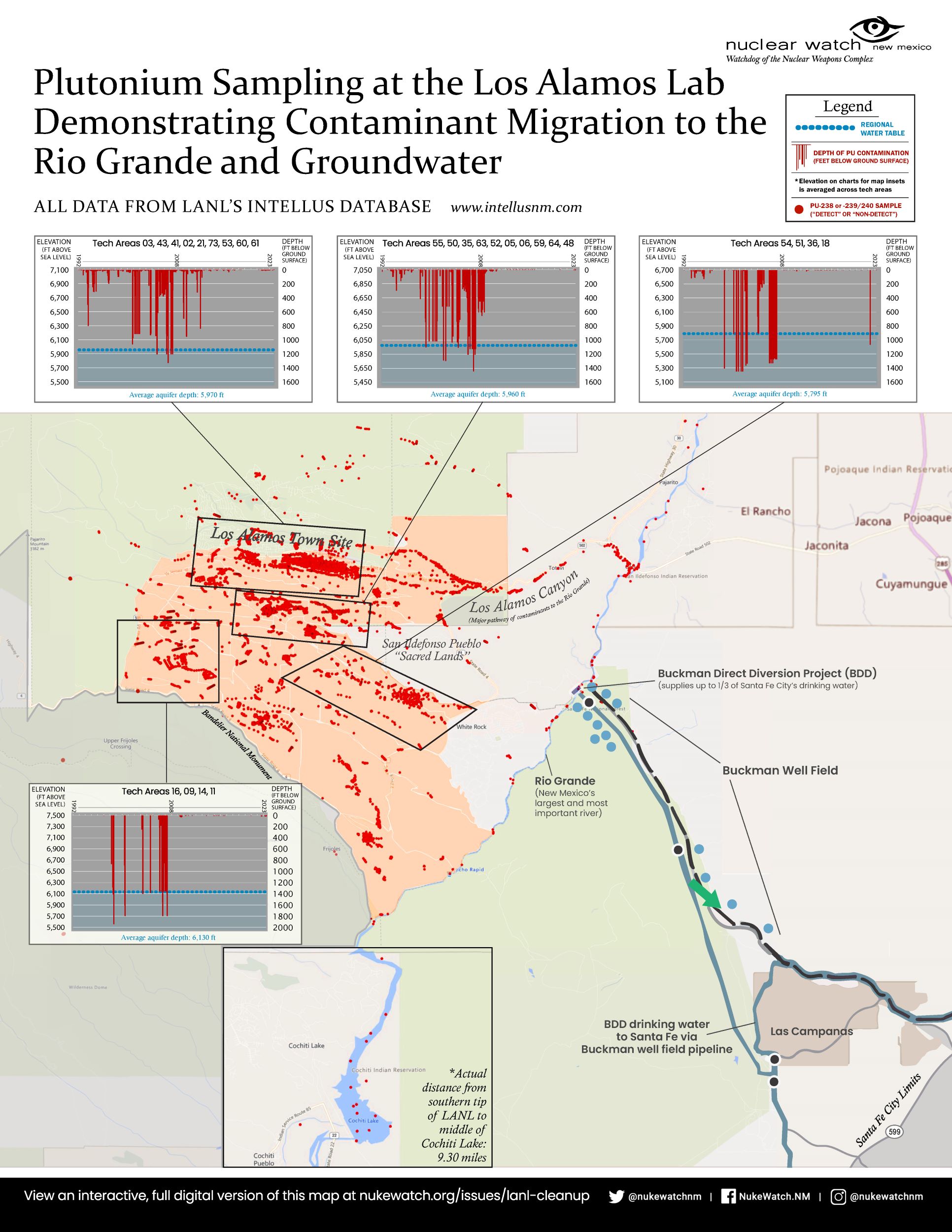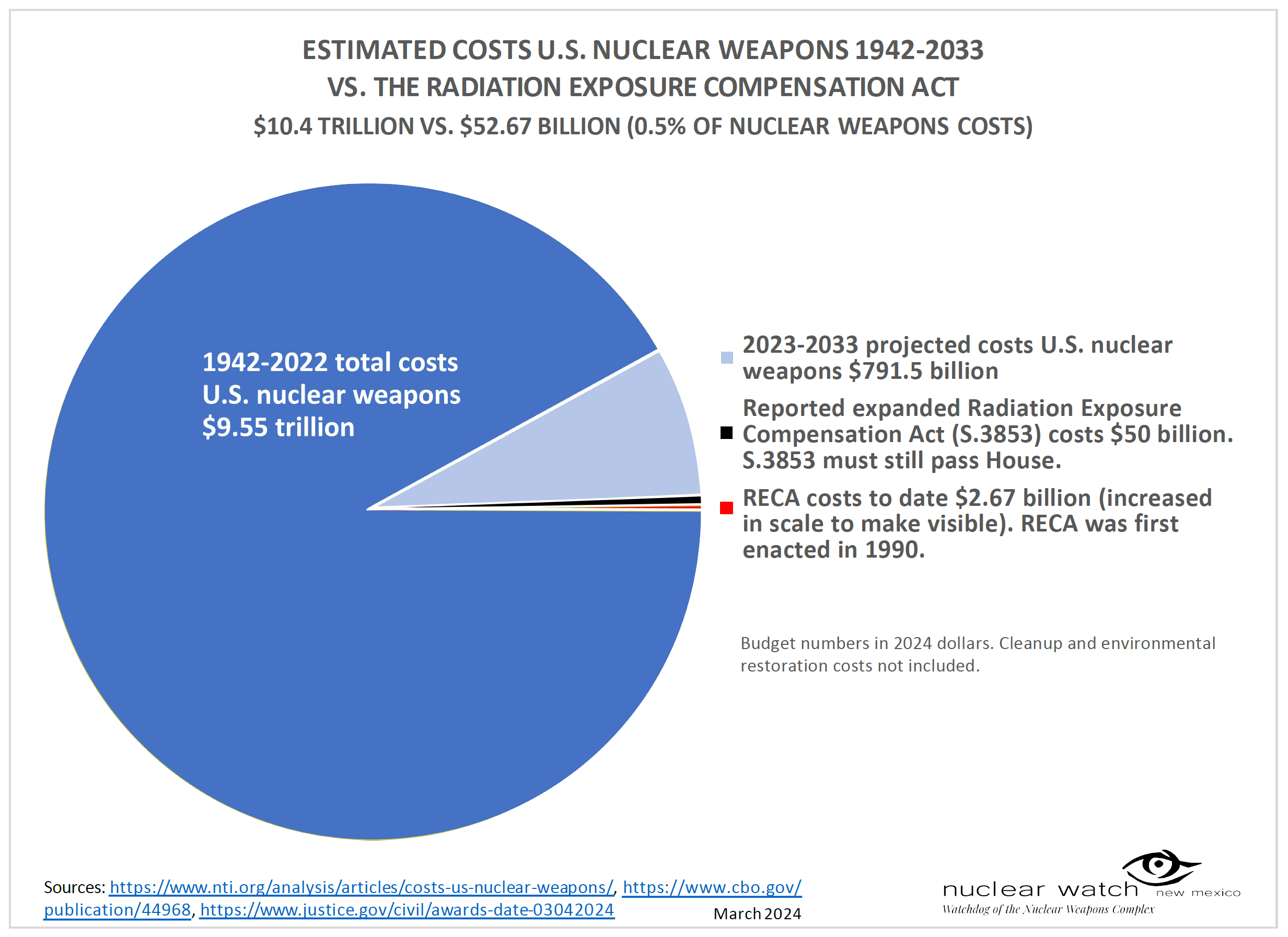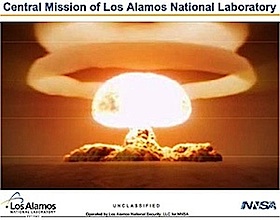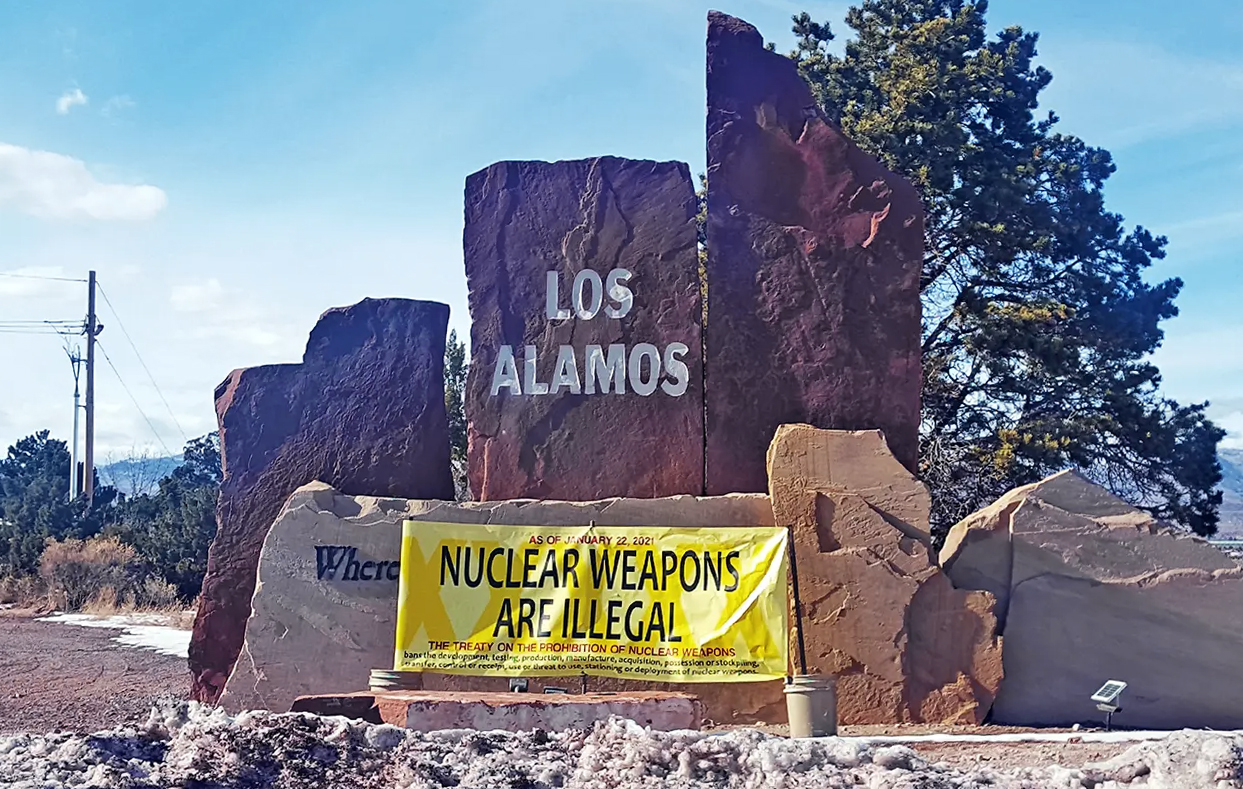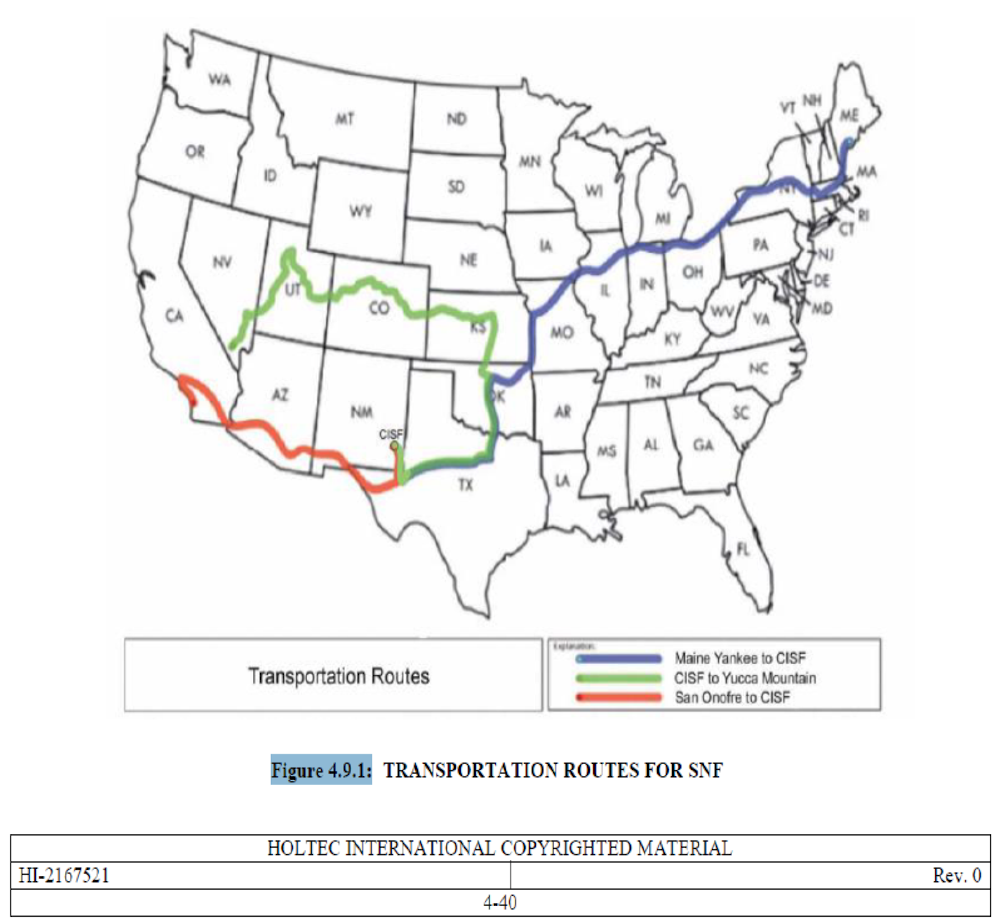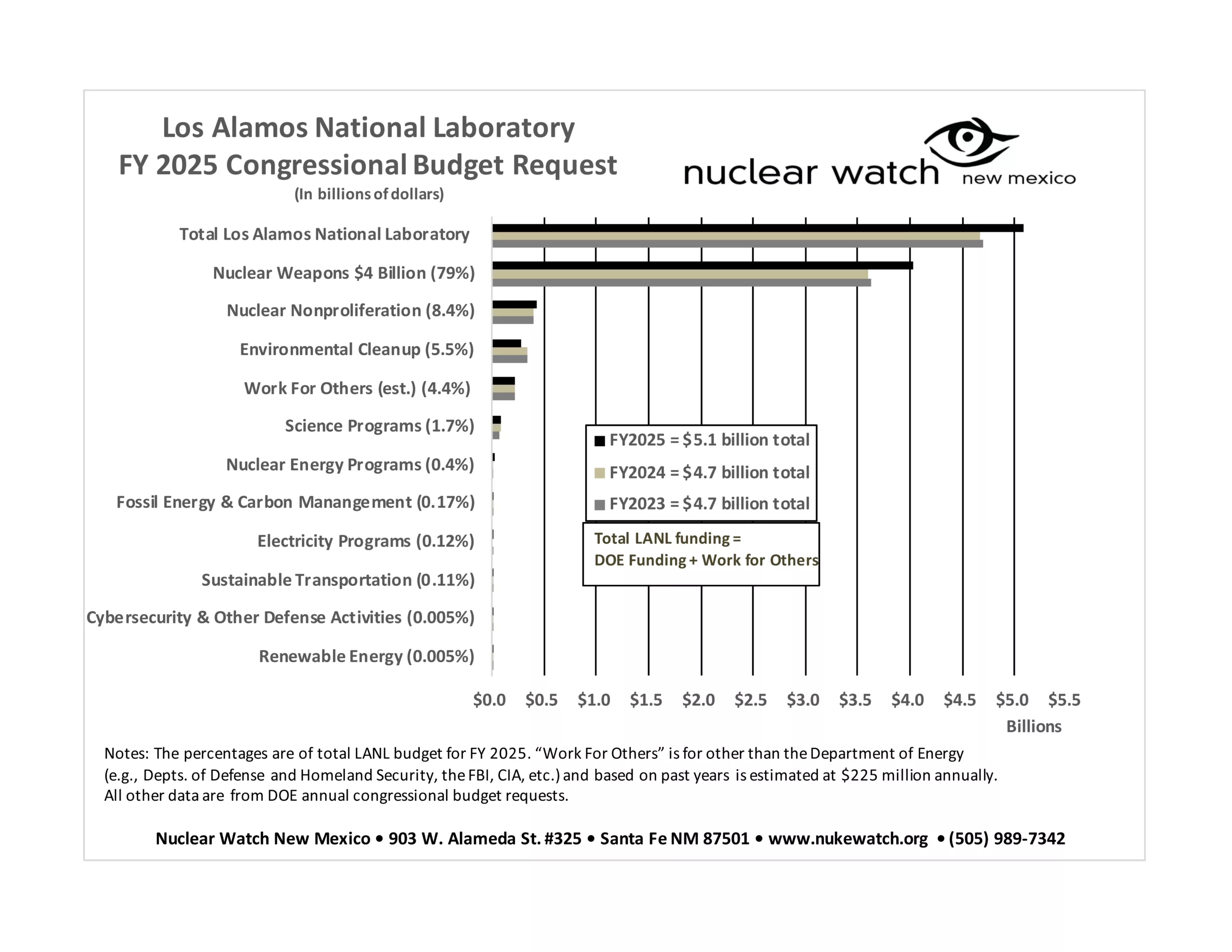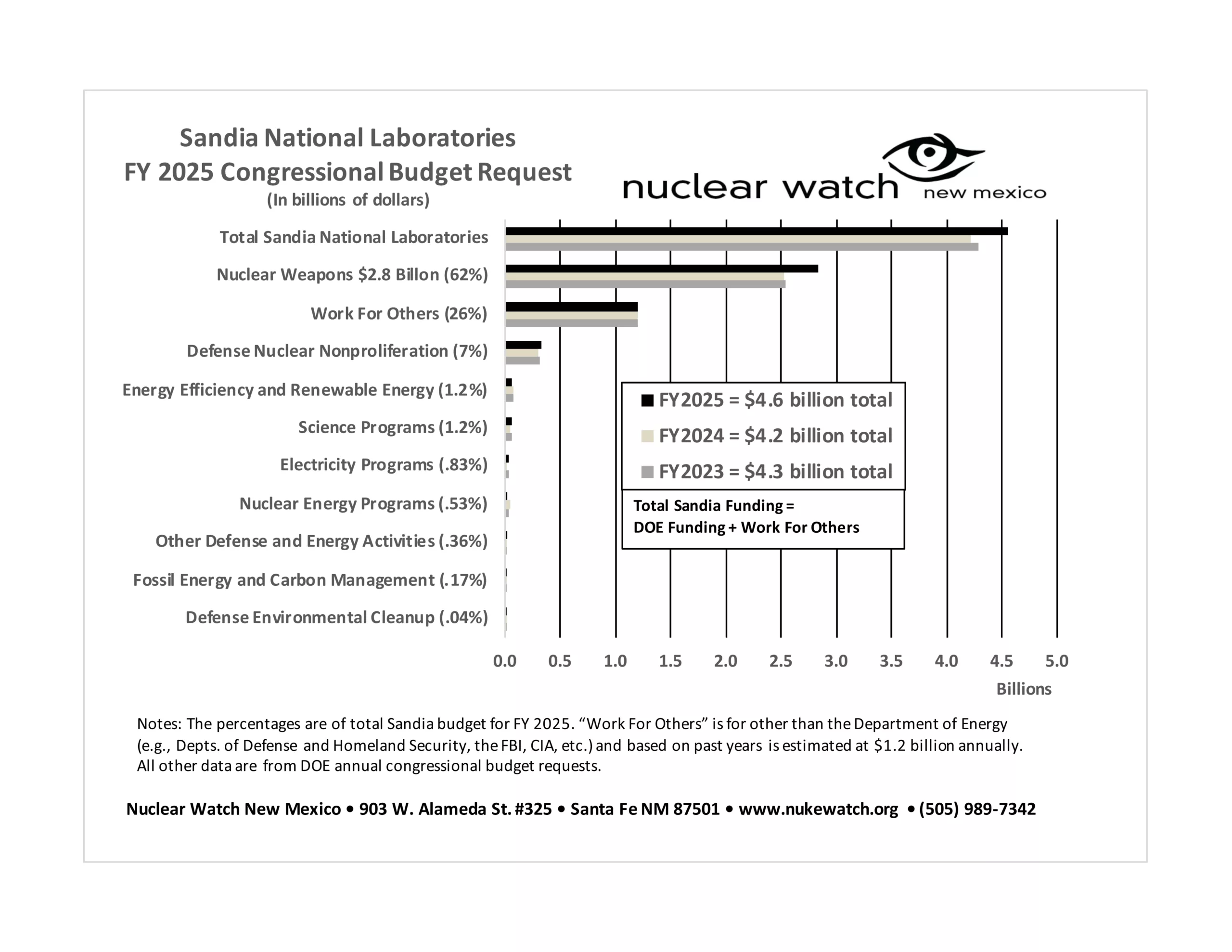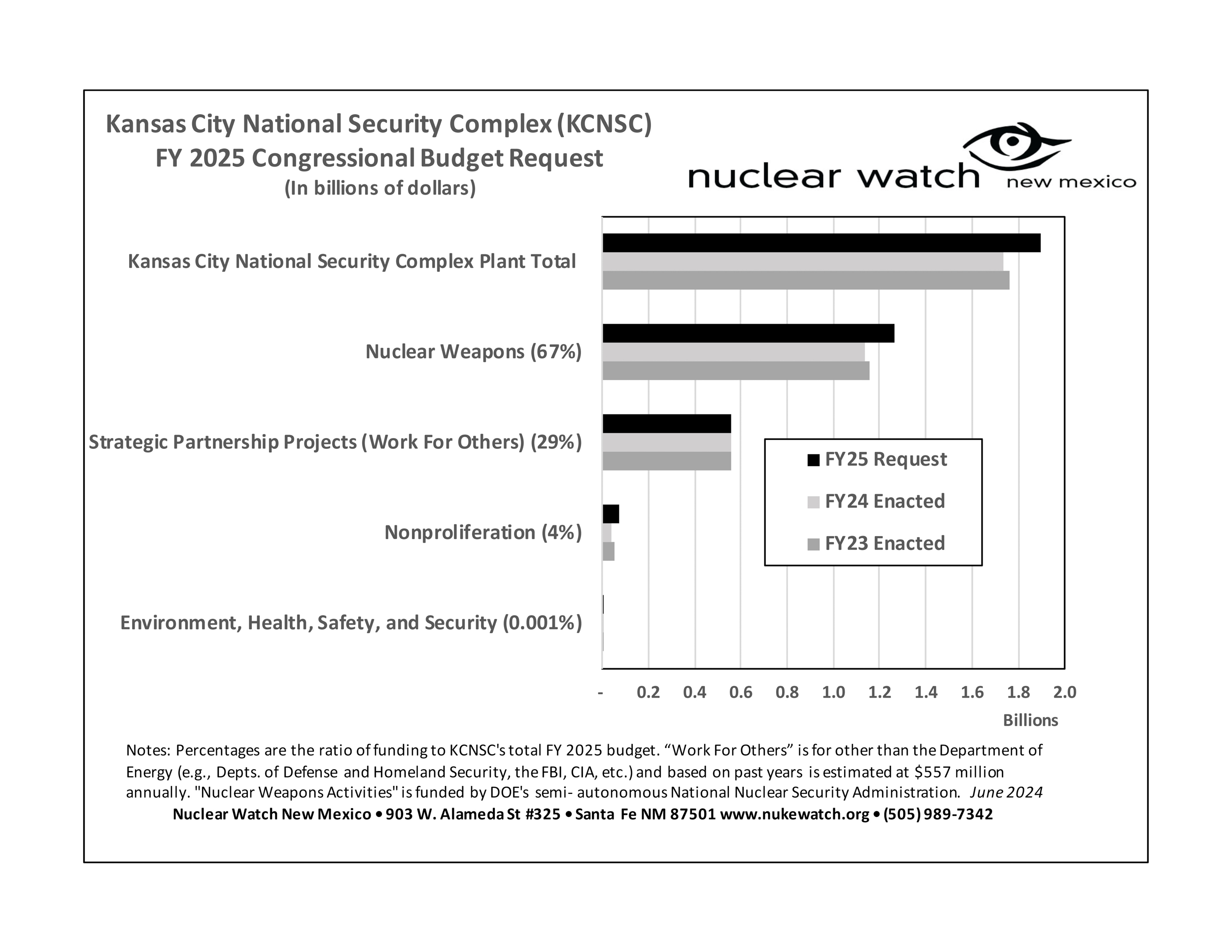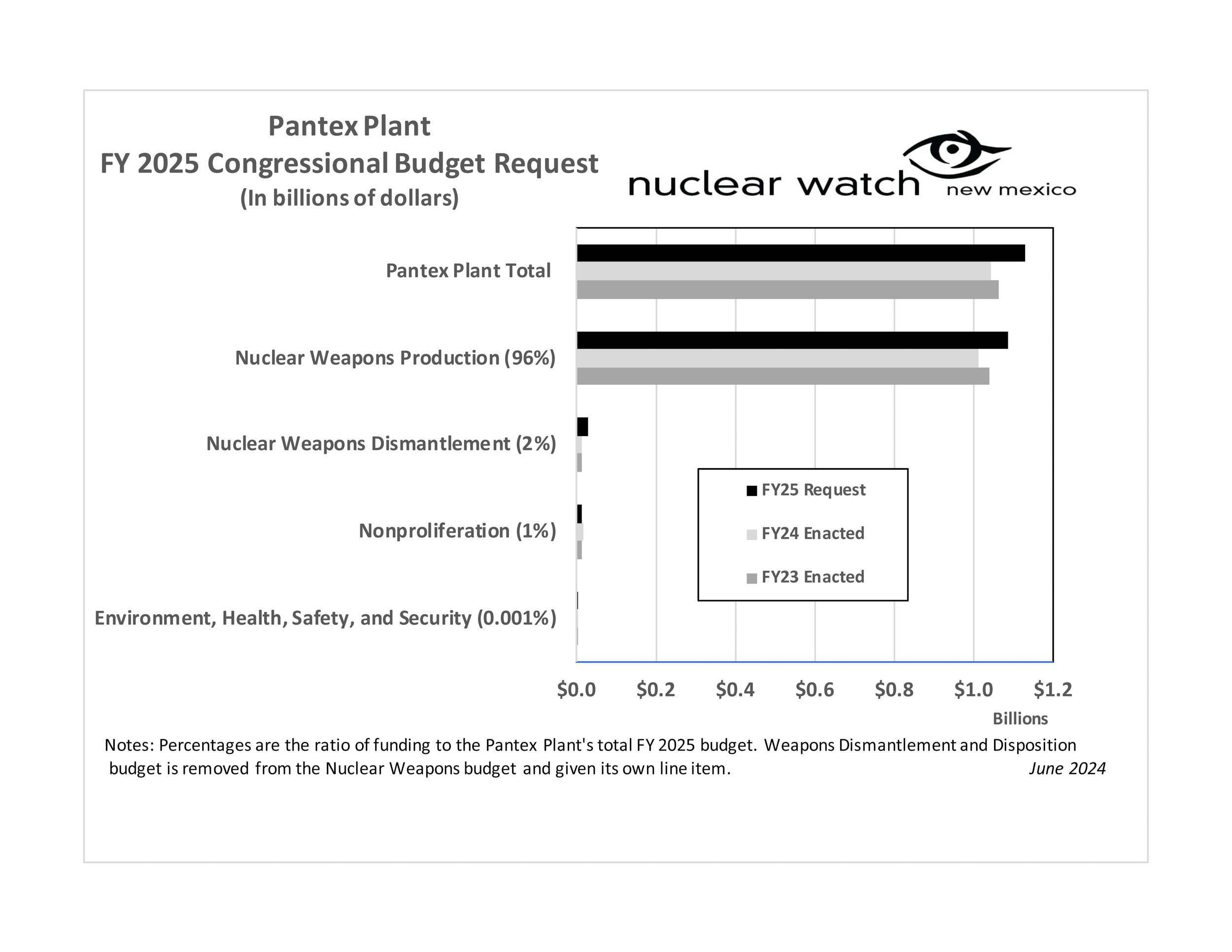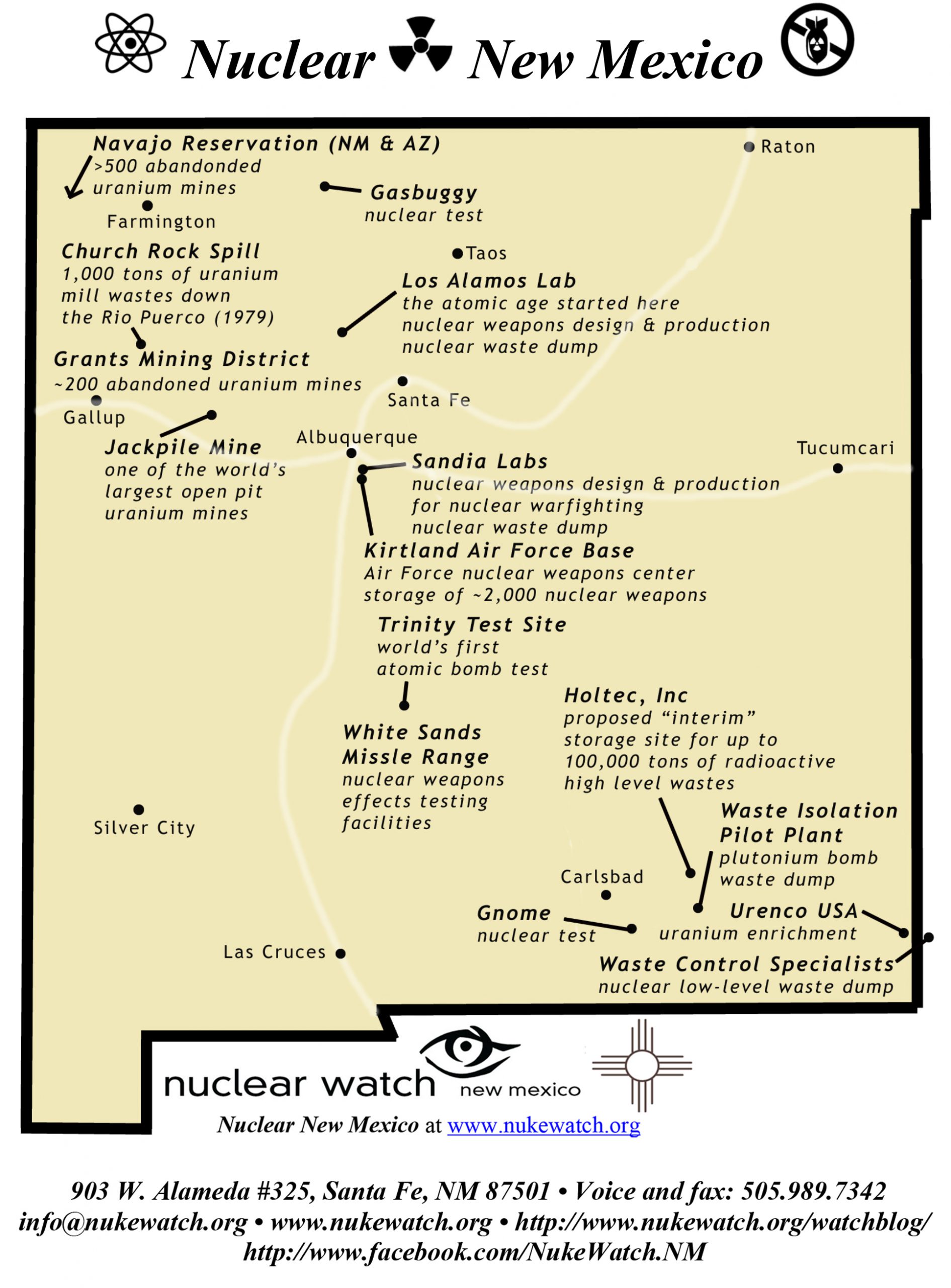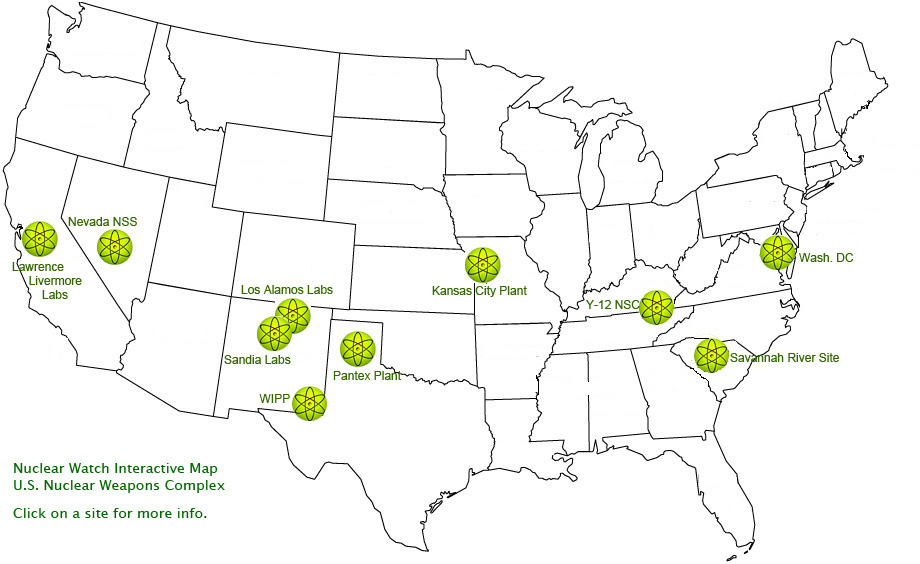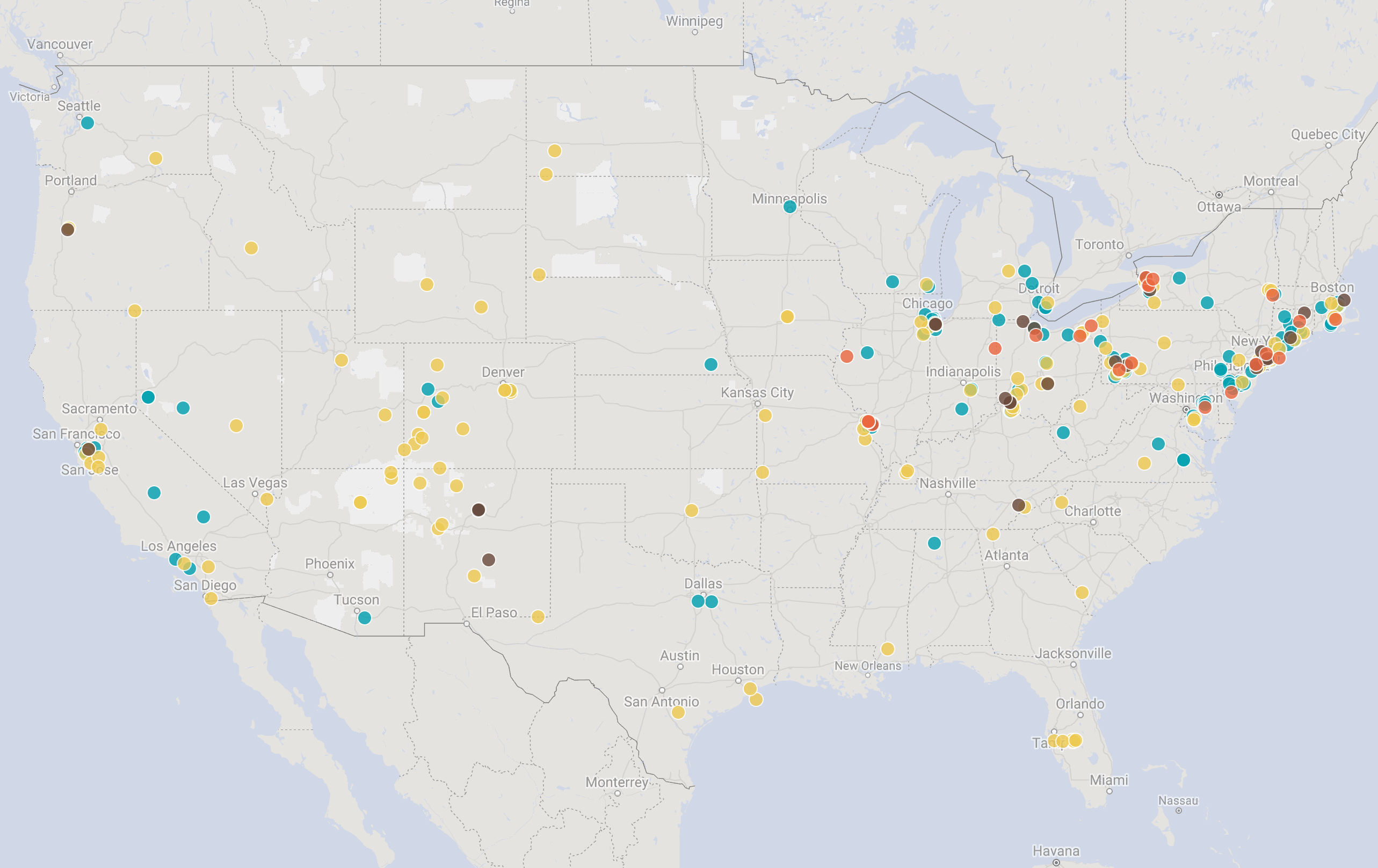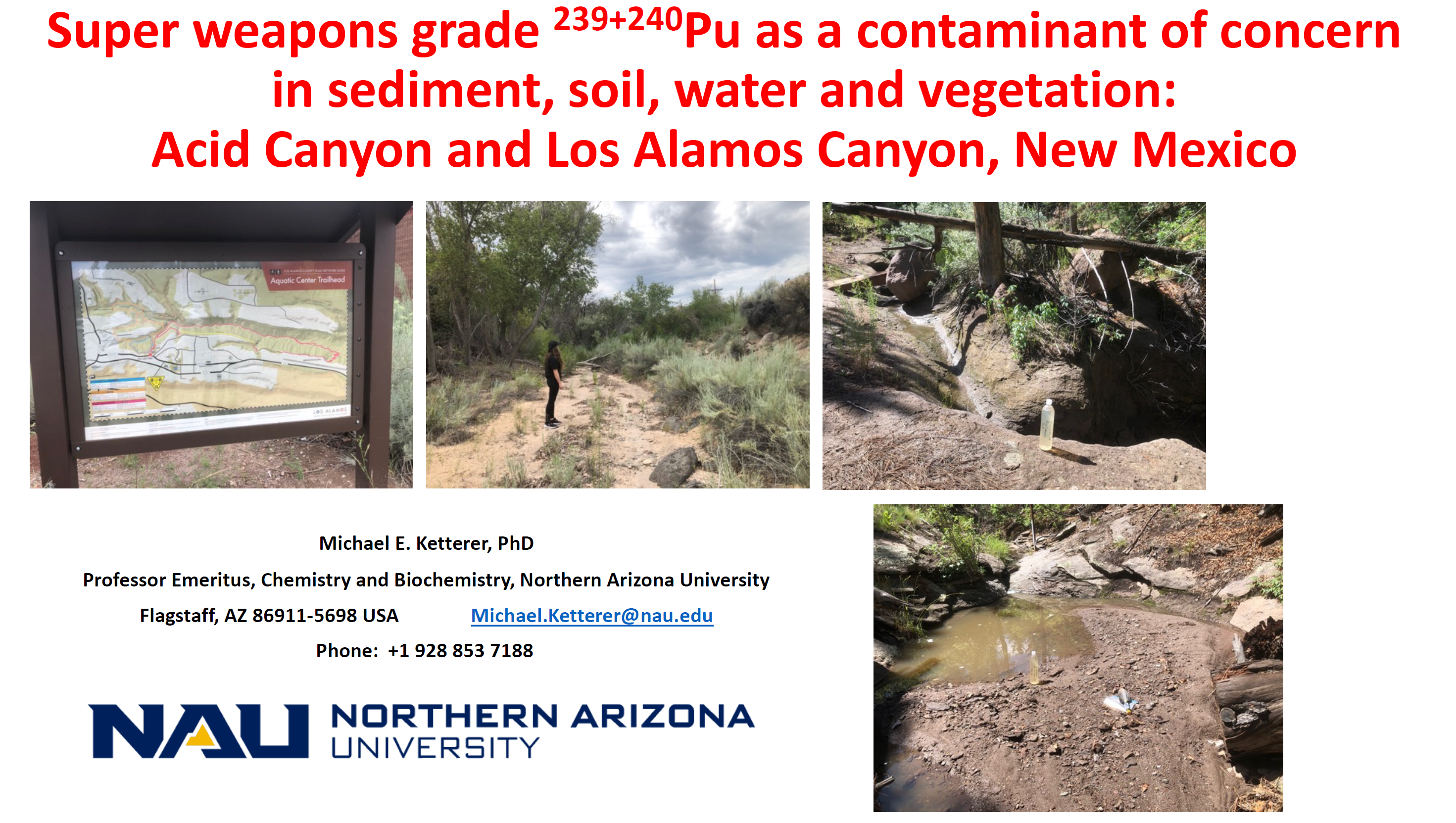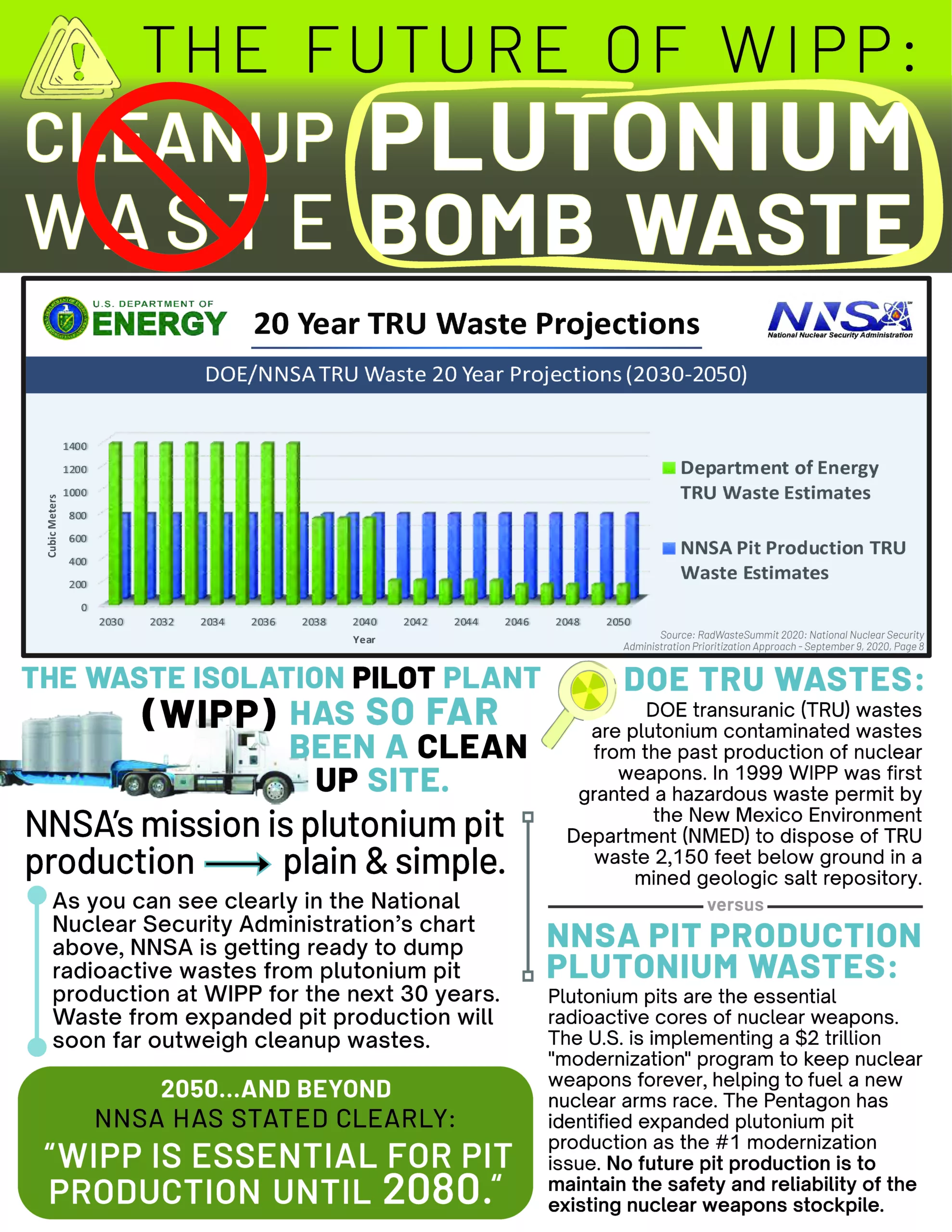QUOTE OF THE WEEK
Nothing Found
It seems we can’t find what you’re looking for. Perhaps searching can help.
LANL’s Central Mission: Los Alamos Lab officials have recently claimed that LANL has moved away from primarily nuclear weapons to “national security”, but what truly remains as the Labs central mission? Here’s the answer from one of its own documents:
LANL’s “Central Mission”- Presented at: RPI Nuclear Data 2011 Symposium for Criticality Safety and Reactor Applications (PDF) 4/27/11
Banner displaying “Nuclear Weapons Are Now Illegal” at the entrance in front of the Los Alamos National Lab to celebrate the Entry Into Force of the Nuclear Weapon Ban Treaty on January 22, 2021
Nothing Found
It seems we can’t find what you’re looking for. Perhaps searching can help.
Follow the Money!
Map of “Nuclear New Mexico”
In 1985, US President Ronald Reagan and Russian President Mikhail Gorbachev declared that “a nuclear war cannot be won and must never be fought.”
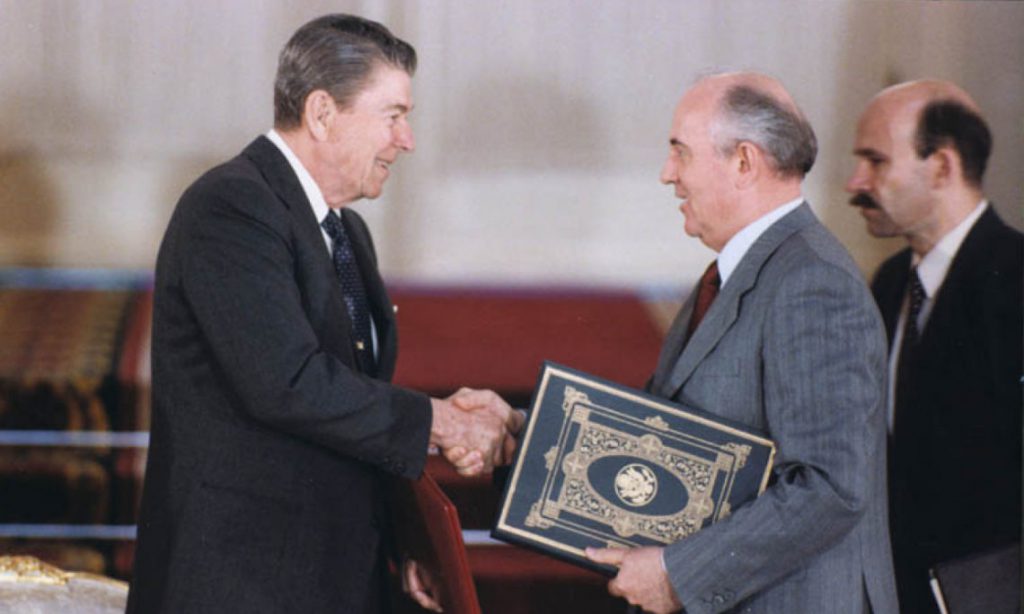
Waste Lands: America’s Forgotten Nuclear Legacy
The Wall St. Journal has compiled a searchable database of contaminated sites across the US. (view)
Related WSJ report: https://www.wsj.com
New & Updated
Nothing Found
It seems we can’t find what you’re looking for. Perhaps searching can help.
High Detections of Plutonium in Los Alamos’ Acid Canyon
Nothing Found
It seems we can’t find what you’re looking for. Perhaps searching can help.
GAO report on NNSA’s dismantlement program
There are lots of interesting nuggets in the Government Accountability Office’s recent dismantlement report. “Nuclear Weapons: Actions Needed by NNSA to Clarify Dismantlement Performance Goal,” April 2014, GAO-14-449, www.gao.gov/assets/670/662840.pdf
Selected highlights below. Verbatim excerpts follow page numbers (add 5 for PDF page number). General points in italics are mine.
Republican presidents, not Dems, make significant stockpile cuts, and do so unilaterally.
1: …in September 1991, the President announced several unilateral initiatives to reduce the U.S. nonstrategic nuclear weapons arsenal. The following month, the Soviet President responded that the Soviet Union would reduce its nonstrategic nuclear weapons. In addition, as part of the annual presidential stockpile review process, in 2004, the President directed that the U.S. nuclear weapons stockpile be reduced by more than 40 percent by 2012 and, in 2007, he directed an additional reduction of the stockpile, making it roughly one-quarter the size of cold war-era levels.
Dismantlements resulting from New START are being held hostage to construction of the Uranium Processing Facility and the Chemistry and Metallurgy Research Replacement Nuclear Facility at LANL.
29: DOD officials told us that the retirement of additional weapons from the stockpile stemming from New START will be predicated on the successful restoration of the NNSA weapons production infrastructure, including the construction and operation of new NNSA facilities supporting nuclear weapons production—the Chemistry and Metallurgy Research Replacement Nuclear Facility at LANL, and the Uranium Production Facility at Y-12—which they did not believe could be achieved until the late 2020s or early 2030s.
Pantex dismantlement workforce could be lost.
29: …this gap in dismantlement workload in the mid-2020s could result in the loss of certified dismantlement personnel because dismantlement technicians at Pantex lose their certifications if they have not worked on a weapon type within the past year. As a result, Pantex may need to retrain and recertify sufficient numbers of new dismantlement personnel in the late 2020s to resume dismantlement efforts to address retired weapons stemming from New START.
NNSA dismantlement rates have plummeted.
21: According to our analysis of dismantlement data, since the early 1990s, NNSA’s dismantlement rates have generally decreased, with NNSA dismantling about 1,000 fewer weapons annually in recent years than it was dismantling in the mid-1990s. In addition, in some years, only one or two types of retired war reserve weapons were dismantled.
NNSA dismantlement reporting is misleading.
23: How NNSA measures progress toward its performance goal of dismantling all weapons retired prior to fiscal year 2009 by the end of fiscal year 2022 is unclear and may make its reported progress misleading, including its practice of not tracking the actual date of retirement of individual dismantled weapons and its plans to reinstate to the stockpile—rather than dismantle—certain weapons retired prior to fiscal year 2009.
Nine percent of “retired” nuclear weapons may go back to the active stockpile.
25: …how NNSA measures progress toward its dismantlement performance goal is also unclear and may be misleading because some weapons retired prior to fiscal year 2009 are reinstated to the stockpile rather than dismantled. Specifically, in our analysis of NNSA’s dismantlement schedule as of March 2013 for weapons retired prior to fiscal year 2009, we found that approximately 9 percent of the weapons retired prior to fiscal year 2009 are scheduled to be reinstated during fiscal year 2013 through fiscal year 2022 or later.
Long retired weapons may come back to active stockpile.
27: The W84-0s and W80-1s currently in managed retirement may not be available to NNSA for dismantlement prior to fiscal year 2022 because both of these systems are being held in managed retirement as candidates for potential reuse as the warhead on a future long-range standoff missile to replace the Air Force’s current ALCM.
Contrary to NNSA claims Life Extension Programs will not decrease total stockpile size, especially when coupled with slower dismantlement rates.
28: As a hedge against technical problems in the life extension program process and in the refurbished warheads, however, the W76-0s are to remain in managed retirement and be unavailable for dismantlement until the life extension program processes and W76-1 unit reliability are “satisfactorily established,” …creating uncertainty as to whether the W76-0s in managed retirement will be released to NNSA in time for dismantlement by the end of fiscal year 2022.
Inconsistent W76-1 production.
28: These officials stated that it would be difficult to predict the completion of the W76-1 life extension program given inconsistent production, and that it was impossible to say whether the W76-0s in managed retirement could be released for dismantlement prior to fiscal year 2019 without additional confidence in NNSA’s production capability.
New START does not change total stockpile numbers, and as previously stated retired weapons can be pulled back to the active stockpile.
29: DOD officials said that the United States will meet the New START ceiling—1,550 operationally deployed nuclear weapons—to be in force by 2018 by transitioning currently deployed nuclear weapons to nondeployed “hedge” status without any significant change in the total stockpile size.
Interesting allusion to the Navy’s lack of support for the interoperable warhead, which could doom it for good.
32: …potential loss of military interest in a future planned common, or interoperable, warhead to replace the W78 and W88
GAO quotes NNSA estimated amounts for accelerated dismantlements, which might be handy for advocacy purposes. However, perhaps as a matter of its timing, the report fails to note the Obama Administration’s proposed 45% cut for dismantlement funding in FY 2015. Separately, the FY 2015 NNSA Stockpile Stewardship and Management Plan states that dismantlements are only 1% of funding for Direct Stockpile Work.
33: NNSA estimated at the time that approximately $212 million in additional funding on top of the projected baseline budgets… would be needed to achieve the fiscal year 2018 dismantlement scenario. Alternatively, NNSA estimated that $265 million in additional funding on top of the projected baseline budgets… would be needed to achieve the fiscal year 2020 scenario.
Dismantlements save money!
35: According to Navy officials we interviewed, accelerating dismantlement of retired W76-0 warheads allowed the Navy to avoid constructing new weapon storage facilities, saving the Navy approximately $190 million in estimated construction costs.
41: NNSA is retaining two types of CSAs [Canned Subassemblies, AKA secondaries] as options for reuse in a potential future W78 warhead refurbishment… In addition, NNSA is also retaining four types of CSAs as options for reuse in a warhead on the Air Force’s planned long-range standoff missile… NNSA officials told us that CSAs associated with a certain warhead indicated as excess in the 2012 Production and Planning Directive are being retained in an indeterminate state pending a senior-level government evaluation of their use in planetary defense against earthbound asteroids… the national labs’ retention letter has also characterized the CSA associated with this warhead as an “irreplaceable national asset.”
42: Y-12 is projected to disassemble far fewer CSAs than in NNSA’s 2009 Production and Planning Directive.
45: As of May 2013, Pantex was storing 3 million mark quality nonnuclear components as a contingency inventory for potential reuse in maintaining active stockpile or refurbished weapons.
49: Pantex site contractors told us that some of these boxes may contain parts that are up to 60 years old and that may be radiologically contaminated, which makes them difficult to handle and identify.
After a Failed Campaign, the State Must Return to Enforceable Cleanup At LANL
After a Failed Campaign, the State Must Return to Enforceable Cleanup At LANL
The June 30 deadline of the “3706 Campaign” to remove 3706 cubic meters of transuranic waste stored on the surface on Los Alamos Lab will be missed due to the radiation release and shutdown of the Waste Isolation Pilot Plant. The campaign was part of a non-binding agreement with the NM Environment Department so there are no penalties associated with lack of performance. The problem is that much other cleanup at the Lab was delayed while the 3706 Campaign was prioritized.
The Lab missed the low bar of shipping 3,706 cubic meters of transuranic waste while the cleanup of over 1,000,000 cubic meters of all types of radioactive waste, hazardous waste, and contaminated backfill buried across the Lab were put on the back burner. These vast amounts of buried wastes, dating back to the Lab’s early days, are covered under a 2005 Consent Order for the “fence-to-fence” cleanup of legacy waste. The Consent Order is enforceable with stipulated penalties of up to $3000/day for missed deliverables. But NMED has been hesitant to impose fines, because of DOE claims that the fines come out of the cleanup budget. The deadline for the last cleanup under the Consent Order is currently December 2015, which everyone agrees is impossible. But that end date could be extended, and should be extended, especially if the Lab was actually working on the legacy cleanup
NMED, to date, has granted over 95 extensions for Consent Order deliverables in favor of the 3706 Campaign. These extensions allow the Lab to not drill monitoring wells and to not perform cleanup investigations and work plans for sites across the Lab. The Lab claims that there is not enough money to address all the Consent Order deliverables, but the idea behind the Consent Order was that fines and the threat of fines would shake cleanup funding from DOE headquarters in DC. Cleanup without the big stick of possible fines just takes us back to the time when the small budget received annually just gets sprinkled around to where the cleanup “priorities” are perceived to be. Urgency and comprehensiveness go out the window.
The Cold War has been over for twenty years now and we in Northern New Mexico have been patient in removing LANL’s legacy waste.
But now Northern New Mexico has neither a 3706 Campaign that is complete, nor a Consent Order that will be complete by its deadline. NMED officials have stated, upon the successful completion of the 3706 Campaign, that they would consider renegotiating the Consent Order. We are waiting to see how NMED deals with the 3706 failure and we urge NMED to make the Consent Order the priority again. The Campaign approach has now been proven not to work.
In the meantime, we also have contaminated WIPP workers.
We have 707 possibly explosive drums probably created by Los Alamos spread across New Mexico and West Texas.
We have a damaged WIPP, which is shut down for up to three years and missing its deadlines for disposing waste.
We have other impacted DOE sites across the country, which will be missing deadlines for radioactive waste disposal.
We the taxpayers are no doubt going to spend hundreds of millions on this fiasco while the contractors continue to put money in their pockets.
The New Mexico Environment Department is the regulator here. Relying on LANL’s promises and plans to make things better must end. Time to return to the 2005 Consent Order and actually use the enforceable provisions in it.
LANL Management Irregularities Continue
LANL Management Irregularities Continue
Los Alamos National Security (LANS), the private consortium that runs Los Alamos National Laboratory under contract for the federal government will manage $2.1 billion of our taxpayer dollars this year. LANS should remember that they were hired to represent the nation’s interests, not the interests of the for-profit corporations running the Lab.
Scott Sandlin, Albuquerque Journal Staff Writer, reported a $3.64 million judgment against Los Alamos National Laboratory for “breach of implied contract and breach of the duty of good faith and fair dealing.” The plaintiffs claimed that Los Alamos conducted the federally funded bidding process, procurement and subsequent protest “using secret policies and procedures inimical to a fair and open bidding procedure.” The Journal disclosed that, according to the lawsuit, the contract was worth roughly $395 million over the first five years and almost $800 million over the decade.
Despite the judgment, LANS denied that it had departed from procedures and also denied deviating from its customary practices.
This follows the March resignation of Los Alamos National Laboratory Deputy Director Beth Sellers, the second-highest ranking administrator at the Lab, for failure to properly report a potential conflict of interest when her husband received a lab consulting contract in 2012. This was also from the ABQ Journal.
The Lab determined that the consultant agreement did not conform to prescribed LANL procedures and processes.” The consultant/husband charged two hours “for a discussion on environmental matters that never took place” and which was actually a visit to the Santa Fe Opera. Los Alamos National Security (LANS), the private consortium that runs the lab under contract with the federal government, reimbursed the government for over $23,000 for the improper contract.
This comes after the November 2013 revelation that Ex-Congresswoman Heather Wilson was paid by nuclear weapons labs the day after she left office. An Albuquerque Journal article built upon a Department of Energy (DOE) Inspector General investigation, which determined that the Sandia and Los Alamos Labs had made approximately $450,000 in improper payments to Wilson up until March 2011, when she began to campaign for the Senate.
A DOE IG report said that the facts indicate that federal funds were used for prohibited lobbying activities, which that office is still investigating. The Labs were forced to return that money to the government, but not Wilson.
The Albuquerque Journal received the new information concerning the dates of Wilson’s contract with Sandia from Nuclear Watch New Mexico. The watchdog organization obtained the documents by appealing an initially rejected federal Freedom of Information Act (FOIA) request.
Nuclear Watch New Mexico Is A Proud Participant In Give Grande
Give ¡Grande! New Mexico is Tomorrow!
On Tuesday, May 6th, you have the opportunity to support local nonprofits and generate significant funds for causes in New Mexico. Large and small gifts will combine for big impact that will support local efforts!
Just log onto www.givegrandenm.org and give to the nonprofits of your choice. Make a tax-deductible contribution online, and your gifts will be added to those of others as the whole state comes together to support the causes we all care about.
Also, come celebrate with us on Tuesday in Santa Fe! Join us to celebrate New Mexico’s first “Day of Giving” from 3:00-6:00 pm at San Isidro Plaza on the South Side! Print out and bring your Give ¡Grande! receipt to get 10 % off your meal at the Plaza Cafe Southside, the Capitol Bar & Grill, and Pizza Centro.
At 5 p.m. Plaza Cafe Southside will cut a giant cake shaped like the state of New Mexico. We also have invited TV stations to stop by about 5:00 pm to do broadcasts for their evening news.
98.1 Radio Free Santa Fe and 107.5 Outlaw Country will be broadcasting live throughout the celebration, and computers will be available for you to make donations on-site.
The Community Foundation Coalition of New Mexico (Coalition), comprised of the Albuquerque, Taos, Southern New Mexico, New Mexico and Santa Fe Community Foundations, is proud to host Give Grande NM, the biggest online philanthropic event in New Mexico history! Community members will come together to raise as much money as possible for local nonprofits in 24 hours. Every dollar will go directly to nonprofits! It’s a great way to recognize and support the positive work of these local organizations.
Donations will begin being accepted on May 06, 2014 12:00 AM MDT.
Enabled by your contribution Nuclear Watch will continue to work diligently to:
• Oppose so-called “modernization” of the nuclear weapons complex and directly related expanded capabilities for increased nuclear weapons production.
• Oppose modernization of the nuclear weapons stockpile itself, which we believe is substantially about creating new military capabilities through planned “Life Extension Programs.”
• Stop expansion of WIPP.
• Promote comprehensive cleanup at Los Alamos and all DOE sites.
• Promote mission change at LANL. We will continue to redirect the Lab from core nuclear weapons research, testing and production programs to today’s critical national security challenges, such as preventing the proliferation of nuclear weapons, promoting clean national energy independence, and studying global climate changes.
• Strive to be your worthy representative locally and in Washington, DC, on nuclear weapons issues that affect our communities, New Mexico, the nation, and the world.
Thank you!
U.S. Nuclear Weapons Agency Claims Phony Budget Savings
New Report: U.S. Nuclear Weapons Agency Claims Phony Budget Savings;
Misleads Congress and Taxpayers About Real Costs of New Warheads; Nonproliferation and Dismantlement Programs Cut
Santa Fe, NM – The House Armed Services Committee is currently pushing a defense bill that pushes back against the Obama Administration’s plans to delay production of a new air launched cruise missile warhead and new nuclear warheads that would be “interoperable” between land-based ICBMs and sub-launched missiles. Related, the bill also calls for speeding up expanded plutonium pit production at the Los Alamos National Laboratory.
The House Armed Services Committee is objecting to delays, but not the substance, of plans by the Department of Energy (DOE) to heavily modify existing nuclear weapons during “Life Extension Programs” to create the new nuclear warheads. DOE’s FY 2014 “Stockpile Stewardship and Management Plan” (SSMP), which first introduced these new warheads, caused considerable sticker shock in Congress. Now DOE has released a new FY 2015 SSMP that it claims is “generally affordable and more executable than the program proposed in the FY 2014 SSMP.” However, an analysis by Nuclear Watch New Mexico concludes that DOE’s new sales pitch is based on overly optimistic claims and outright omissions that should alarm Congressional budget hawks.
DOE’s nuclear weapons agency, the National Nuclear Security Administration (NNSA), is notorious for cost overruns. Its FY 2015 plan misrepresents reduced costs by:
• Delaying projects and their costs – which almost always results in higher total costs.
• Lowering budget estimates while claiming undocumented improved cost modeling – when NNSA has an abysmal record in cost estimates.
• Claiming $7.5 to $9.5 billion in savings for NOT doing a Life Extension Program – which in fact was never planned.
• Omitting costs of directly related programs – which may exceed the costs of the Life Extension Programs themselves.
• Depicting costs as gradually tapering off – while failing to disclose that even more expensive follow-on programs are planned 20 years after the first round of Life Extension Programs.
• Perhaps most significantly, assuming the armed services will help pay for heavily modified nuclear weapons – when in fact the U.S. Navy does not want them (see internal memo below).
Missing is justification of why an extensively tested, reliable stockpile needs to be heavily modified during Life Extension Programs. According to a recent DOE Inspector General audit report, NNSA failed to diligently keep original “as-built” designs, when that information “is the foundation upon which the NNSA surveillance program assesses the current stockpile. Without it, NNSA loses confidence in its nuclear weapons stockpile assessments.” Changes could possibly erode confidence in nuclear weapons reliability, especially if original design information is lacking as a baseline.
The non-partisan Congressional Budget Office (CBO) recently reported that NNSA and the Pentagon plan to spend $355 billion over the next decade on nuclear weapons and their delivery systems. Meanwhile, the Obama Administration’s FY 2015 budget request cuts funding for nonproliferation, dismantlement and nuclear safety programs, and keeps cleanup funding flat.
Jay Coghlan, Nuclear Watch Director, commented, “Congress should demand that NNSA rigorously justify any proposed changes to existing reliable nuclear weapons. The antidote to exorbitantly expensive, potentially harmful modifications to the reliable stockpile is genuine stewardship that would preserve original weapons designs. This is far less risky and provocative, and would free up money for critically needed nonproliferation, dismantlement, nuclear safety and cleanup programs.”
Strongly recommended: Nuclear Watch’s detailed analysis of NNSA’s FY 2015 Stockpile Stewardship and Management Plan, including sources and key NNSA excerpts https://nukewatch.org/importantdocs/resources/FY2015-SSMP-analysis.pdf
An Executive Summary is available at https://nukewatch.org/importantdocs/resources/FY2015-SSMP-analysis-summary.pdf
# # #
The NNSA FYs 2014 and 2015 Stockpile Stewardship and Management Plans are available at https://web.archive.org/web/20170714130201/https://nnsa.energy.gov/ourmission/managingthestockpile/ssmp
The Congressional Budget Office report Projected Costs of Nuclear Forces 2014 -2023 is available at http://www.cbo.gov/sites/default/files/cbofiles/attachments/12-19-2013-NuclearForces.pdf
For U.S. Navy lack of support for heavily modified nuclear warheads see “Navy Perspective of W78/88 LEP Phase 6.2,” September 27, 2012, https://nukewatch.org/importantdocs/resources/Navy-Memo-W87W88.pdf
NNSA Digs Deep To Find A Reason To Give Itself Award
The award for the largest nuclear facility project completed ahead of schedule and under budget by NNSA goes to a project came in only 1% under budget after spending $40 million in contingency.
In an April 2 2014 National Nuclear Security Administration press release titled, NNSA Receives Secretary’s Award for Project Management Excellence, the Chemistry and Metallurgy Research Building Replacement (CMRR) Radiological Laboratory/Utility/Office Building (RLUOB) Equipment Installation (REI) Project was touted for coming in $2 million under budget.
First, the CMRR is the now-deferred project at Los Alamos, whose third phase Nuclear Facility would have enabled increased plutonium pit production. The RLOUB was the first phase of the CMRR project. The second phase REI is only the “equipment” for the RLOUB.
The press release tells us –
“The REI installed glovebox and other enclosure systems, analytical and test instrumentation equipment, and telecommunications and safeguards/security systems within the RLUOB.”
Also included, but not mentioned in the press release, were a fuel oil storage tank, furniture, and the parking lot.
It looks like NNSA gave the award in part because it could have been worse. With one year left in the 3-year the contract, it was estimated that the project was $8 million over budget. So NNSA put a new team in charge and straightened out their mess-ups and turned it around to a $2 million savings.
The press release tells us –
“The CMRR/RLUOB REI Project is the largest nuclear facility capital asset project completed ahead of schedule and under budget by NNSA.”
The press release also neglects to give the total budget. Our documents show that REI had a total budget $199 million. That makes the $2 million that the REI came in under budget equal to 1% of the total budget.
But our documents also show that there was $41.6 million (26%) contingency included in the $199 total budget. After spending untold millions in design and then estimating the cost of the project, NNSA adds in a large contingency to every project so that it does not go over budget and have to go back to Congress for more money.
Is the REI, which spent $40 million in contingency, really $2 million under budget?
I think not. NNSA must give the public all the facts and figures when it gives glowing appraisals of itself.
Here’s what we have on the REI –
WIPP Continues to Show Signs, Town Hall Webcast Tonight, LANL TRU to WCS, More Information
WIPP Continues to Show Signs, Town Hall Webcast tonight, LANL TRU to WCS, More Information
WIPP Underground Continues to Show Signs of Radiological Activity
The Waste Isolation Pilot Plant officials stated that there was another radiological release on March 11. This was outside of the WIPP site exhaust shaft filter. An air sample from the outside of the ventilation exhaust recorded 61 disintegrations per minute of americium on a sample collected the evening of March 11. WIPP stated that, “This is expected given the amount of contamination captured by the WIPP ventilation system during the February 14 radiation release event. Engineers believe the contamination was from previous deposits on the inner surface of the exhaust ductwork.” The engineers did not state why they expected this and did not mention the LARGE amount of contamination captured by the WIPP ventilation system filters. The engineers also did not state why they believed this and not that more contamination was being produced in the underground.
Air sampling results before and after the High Efficiency Particulate Air (HEPA) filters at WIPP are available here. Station A samples air before the filters and Station B samples air after passing through the filters. These samples were analyzed following the detection of airborne radioactivity on February 14, 2014. They are not environmental samples, and are not representative of the public or worker breathing zone air samples.
The 3/11/14 4:19PM increase after the filters is shown here. There were other small releases on 03/02/2014 08:50 AM (38 dpm) and 03/05/2014 08:10 AM (60 dpm, although WIPP claims that the filter was “cross contaminated”)
There was a larger event, before the filters, that occurred 03/13/2014 08:30 AM (368 dpm) that has not been mentioned. All this shows that the underground could still be brewing radiological activity. Perhaps this will be explained better tonight at the Town hall.
Weekly Town Hall Meetings in Carlsbad?
Thursdays at 5:30 – Carlsbad City Council Chambers, City Hall, 101 N. Halagueno St.
Co-hosted by City of Carlsbad and U.S. Department of Energy (DOE) Carlsbad Field Office
Discuss recovery efforts following WIPP’s fire and radiological events in February.
Meetings available live online
The Show Goes On
The Department of Energy (DOE), is proposing to ship transuranic waste currently located at the Los Alamos National Laboratory (LANL) for temporary storage at Waste Control Specialists (WCS), located in western Andrews County, Texas. LANL has another ~546 cubic meters remaining out of the original 3706 cubic meters that was agreed to be moved to WIPP by June 2014.
Let’s be clear, there is no technical reason to store the waste temporarily at WSC. DOE and LANL just want to show that they can meet a deadline. The extra cost of this operation has not been released. And don’t get me wrong, no one wants the waste – all the waste – removed from LANL more than me. Let’s hope that DOE and LANL show the same amount of interest and resources when it comes to removing the rest of the waste at Los Alamos, such as the hundreds of thousands of cubic meters of radioactive and hazardous wastes buried at Area G.
Official Websites
New Mexico Environment Department WIPP website
WIPP Informational Meeting in Santa Fe
A WIPP informational meeting will take place in Santa Fe on Monday, March 31st from 6 to 7:30 pm at the Santa Fe Main Library, located at 145 Washington, in downtown Santa Fe. Please note the new location. Don Hancock, of Southwest Research and Information Center, Scott Kovac, of Nuclear Watch New Mexico, and Sasha Pyle, longtime activist, will give presentations. Opportunities for public involvement will be discussed.
Nothing Found
It seems we can’t find what you’re looking for. Perhaps searching can help.
CRITICAL EVENTS
Nothing Found
It seems we can’t find what you’re looking for. Perhaps searching can help.
Nothing Found
It seems we can’t find what you’re looking for. Perhaps searching can help.
New Nuclear Media: Art, Films, Books & More
Nothing Found
It seems we can’t find what you’re looking for. Perhaps searching can help.

